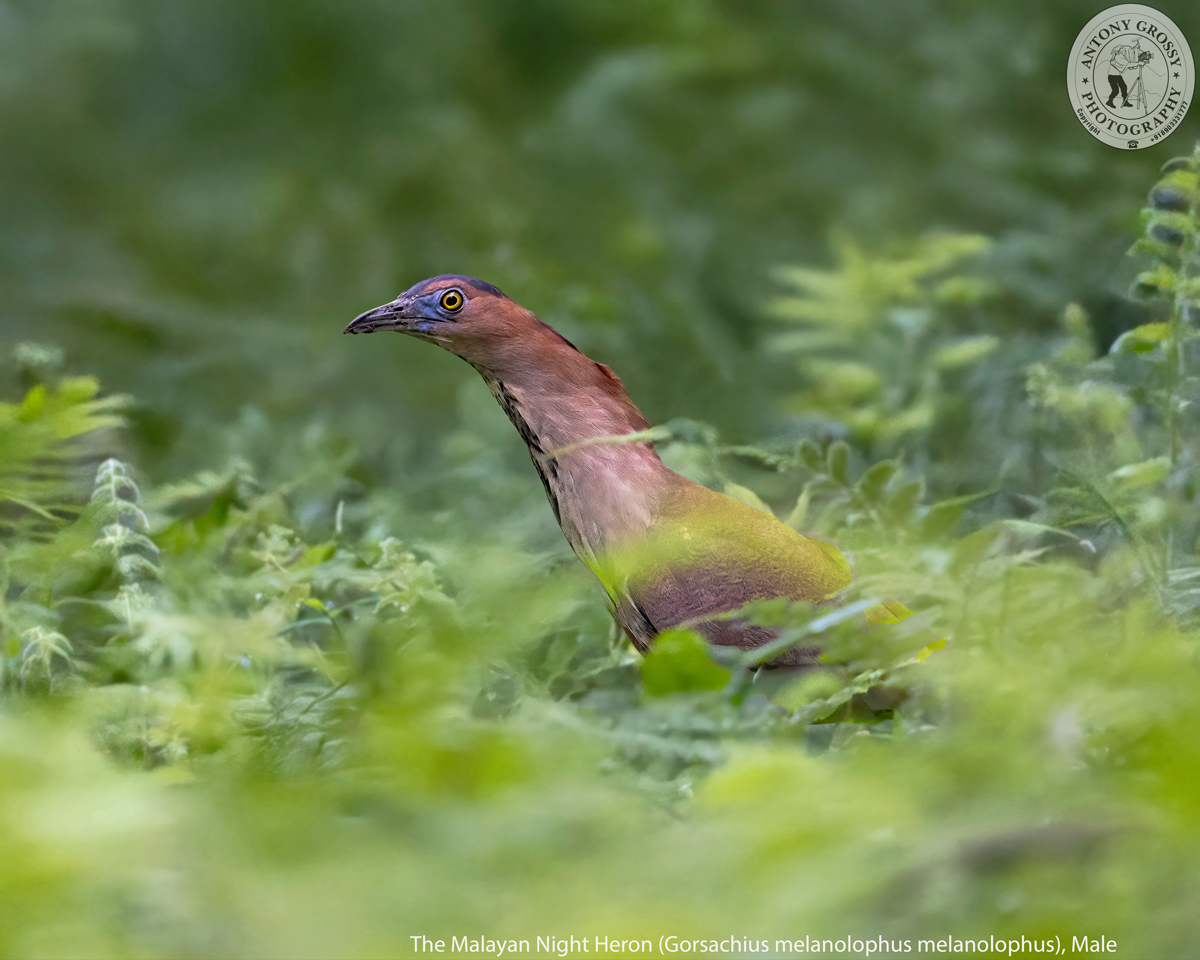

|
 |
| The Shy Reptilian Looking, Nocturnal Migrant Skulker – The Malayan Night Heron, Male |
| The Malayan Night Heron is a bizarre reptilian looking bird with the squat, staring appearance of a toad. The Adult is dark cinnamon-brown with a black crown and a black stripe running from the throat down to the breast. Juvenile is very different, with grey-brown barring all over the body (darkest on the crown). Breeding birds have an especially bright blue facial skin patch between the bill and the eyes; the patch is faded in non-breeders, and yellowish in juveniles. Japanese Night-Heron is similar but averages duller brown with less contrasting black patches. Typically, nocturnal and furtive in forested areas, but can frequently be tame and active during the day as well. . . . . . . …. ………….. ……………….. .. …. …. ……….. … …. ……….. … …. ………… ………….. ………… ………… ….. ………. …………. …….. ……………. …… …. …. ……….. … …. ……….. .. ………… ….. ………. …………. …….. ……………. … The Malayan Night Heron is a medium-sized bird with a unique appearance. It exhibits a combination of dark and light plumage, which helps it blend into its natural habitat. It measures between 45 to 49 cm in length and weighs about 377 to 451 gms. Identified by rufous neck, black cap and crest, white-tipped primaries and chestnut-barred back; separated from the Japanese Night Heron by chestnut-brown body (paler than latter), black (not tawny) crown, longer crest, marginally longer and thinner bill, and white (not tawny) tips to primaries; from the Cinnamon Bittern by short, stubby and slightly decurved (not long and pointed) bill, black crown, bluish-green lores and larger size, among other features; from The Black-Crowned Night Heron by shorter, stubbier bill, smaller size, much finer spotting on back and wings, and mottled (not streaked) underparts. Males have been reported to have deeper blue lores and a longer crest compared to females during the breeding season. Males develop the dark blue lores 30 to 60 days prior to pair-bonding, while females had bluish-green lores when they first appeared in the breeding areas. Colours of the lores of both sexes faded as incubation progressed, with colours changing to bluish-green to green to greyish-green. It roosts in trees and feeds in open areas. It seems to nest singly and not colonially in association with other waterbirds. . . . . . . …. ………….. ……………….. .. …. …. ……….. … …. ……….. … …. ………… ………….. ………… ………… ….. ………. …………. …….. ……………. …… …. …. ……….. … …. ……….. .. ………… ….. ………. …………. …….. ……………. … This Heron’s range extends across Southern and Eastern Asia, with sightings reported in countries including India, Sri Lanka, Brunei, Nepal, Bangladesh, Myanmar, Cambodia, Laos, Vietnam, Thailand, Malaysia, Singapore, China, Indonesia, the Philippines, Taiwan, and Japan. It favours environments such as forests, lowland wooded swamps, streams, and marshes in dense tropical and subtropical forest in areas of heavy rainfall, where it can find ample cover and feeding opportunities. It is typically found at lower altitudes but can also be spotted in foothill regions up to 1,000 mtrs above sea level. . . . . . . …. ………….. ……………….. .. …. …. ……….. … …. ……….. … …. ………… ………….. ………… ………… ….. ………. …………. …….. ……………. …… …. …. ……….. … …. ……….. .. ………… ….. ………. …………. …….. ……………. … The Malayan Night Heron feeds mainly on insects (e.g. beetles), molluscs, large earthworms, frogs, lizards, snakes, whip scorpions, spiders, snails, crabs and probably to lesser extent small fish. Solitary and probably territorial feeder; generally crepuscular or nocturnal, but also occasionally recorded feeding by day, with principal foraging techniques apparently standing and walking slowly. . . . . . . …. ………….. ……………….. .. …. …. ……….. … …. ……….. … …. ………… ………….. ………… ………… ….. ………. …………. …….. ……………. …… …. …. ……….. … …. ……….. .. ………… ….. ………. …………. …….. ……………. … Several calls described including arh, arh, arh in flight, a single low-pitched kwok similar to that of The black-Crowned Night Heron, and song is a deep, hollow, mournful-sounding series of wu, wu, wu or thuk, thuk, thuk, thuk notes (typically 5 to 15, usually 12) of even pitch and tempo (though sometimes hoarser and more distinctly two-toned), given both at dawn and dusk and by night, occasionally during day, while simultaneously erecting crest feathers. . . . . . . . . . . . . . . . . . . . . . . . . . . . . . . . . . . . . . . . . . . . . …………………….. ………………………………………………………………… ………………………………………………………………………………………………………………………………………………………………………………………….. ………………………………. .. ……… …… … …. ……….. Description Credit Birds of the World (The Cornell Lab), Oiseaux, Birda, Animalia, Nepal Desk, Ogaclicks, Birds of India | Bird World, Bird Count India & Wiki. |
  |
|
|























































































































































































































































































































































































































































































































































































































































